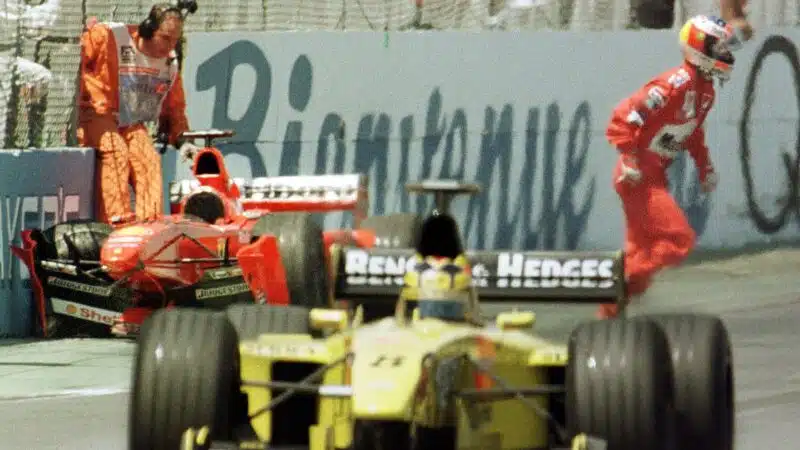In the world of Formula 1, some corners are famous for their speed, others for their technical challenge. But a select few are famous for their brutality. On the Circuit Gilles Villeneuve in Montreal, the final chicane is capped by a simple concrete barrier. It’s grey, unyielding, and carries the ironic greeting, “Bienvenue au Québec” (Welcome to Quebec).
But to F1 fans, it has a far more menacing name: The Wall of Champions.
And the story of how it earned that title is one of F1’s greatest legends, written over one chaotic afternoon in 1999.
The Perfect Trap
The Circuit Gilles Villeneuve is a driver favourite—fast, flowing, and unforgiving. As a semi-permanent street circuit, the barriers are always close. Nowhere is this more apparent than the final chicane at Turns 13 and 14.
To be fast here, a driver must be aggressive. They attack the first right-hand kerb at incredible speed, unsettling the car as they flick it left for the exit. Get it right, and you carry a huge speed advantage onto the long start-finish straight. Get it wrong by a single inch, and the wall on the exit is waiting. There is no runoff. No gravel. Just instant, race-ending contact.
For years, this wall claimed its share of victims. But in 1999, it went after the very best.
The 1999 Canadian Grand Prix: A Day of Carnage
The race was a powder keg of talent. On the grid were multiple World Champions, each a master of their craft. But on that day, the wall proved to be the great equalizer.
It started on lap 15.
🏆 Damon Hill (1996 World Champion), driving for Jordan, got the chicane slightly wrong. A small misjudgment was all it took. He clipped the inside kerb, lost the rear of his car, and slid helplessly into the outside wall. The first champion was out.
Then, on lap 30, the unthinkable happened.
🏆 Michael Schumacher (1994, 1995 World Champion) was in a commanding lead. The Ferrari driver was known for his relentless precision. But even the great Schumacher was not immune. Pushing hard, he made a rare error, hitting the wall with enough force to shatter his front-right suspension. As his car came to a stop, the TV cameras captured a moment of pure disbelief and despair from the German. The race leader was out.
The crowd was stunned. But the wall wasn’t finished. Just five laps later, it claimed its most poetic victim.
🏆 Jacques Villeneuve (1997 World Champion) was the home hero. Racing on a track named after his legendary father, Gilles, the pressure was immense. Chasing down the leaders, he made the exact same mistake. The Canadian driver slammed into the very same spot. The hat-trick was complete.
In the space of just 20 laps, three Formula 1 World Champions had been humbled by the same piece of concrete. The legend was born. From that day forward, it was known only as The Wall of Champions.
A Legacy That Endures
The Wall of Champions wasn’t just a 1999 phenomenon. Its reputation is renewed almost every year. It has since ensnared other champions like Jenson Button and Sebastian Vettel, as well as a host of other talented drivers like Juan Pablo Montoya, Carlos Sainz, and Kevin Magnussen.
It stands as a permanent monument to the fine line between glory and failure in Formula 1. It’s a reminder that even the greatest drivers in the world are human, and that a single lapse in concentration can have spectacular consequences.
Every time the F1 circus returns to Montreal, the cameras linger on that wall. And every driver, from the rookie to the 7-time champion, shows it the ultimate respect as they navigate those final turns. Because they know that the Wall of Champions is always waiting to add another famous name to its list. 💥
Want More F1 Insights Like This?
If you loved this deep dive into Wall of Champions, there’s even more waiting for you on the Purple Sector Club app! Get instant access to all our latest articles, exclusive content, and join the conversation with fellow F1 fanatics.
Download the app now and never miss a beat:



